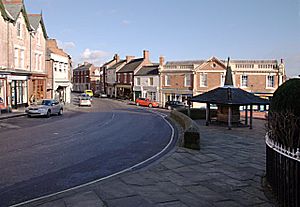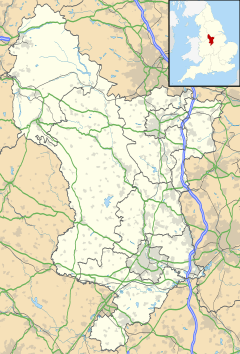Melbourne, Derbyshire facts for kids
Quick facts for kids Melbourne |
|
|---|---|
 The Market Place, Melbourne |
|
| Area | 14.73 km2 (5.69 sq mi) |
| Population | 5,264 (2021) |
| • Density | 925.57 |
| OS grid reference | SK385255 |
| District |
|
| Shire county | |
| Region | |
| Country | England |
| Sovereign state | United Kingdom |
| Post town | DERBY |
| Postcode district | DE73 |
| Dialling code | 01332 |
| Police | Derbyshire |
| Fire | Derbyshire |
| Ambulance | East Midlands |
| EU Parliament | East Midlands |
| UK Parliament |
|
Melbourne is a busy market town in South Derbyshire, England. It's famous for being the home of Thomas Cook. He started the well-known travel company, and there's even a street named after him here!
Melbourne is about 8 miles (13 km) south of Derby. It's also just 2 miles (3 km) from the River Trent. In 2021, about 5,264 people lived in Melbourne.
Contents
What Does Melbourne Mean?
The name Melbourne means 'mill stream'. This means a mill that was built by a stream. The name was first written down in the Domesday Book in 1086. Back then, it was called Mileburne. It was a special royal manor owned by the king.
The big city of Melbourne in Australia got its name from William Lamb, who was the second Viscount Melbourne.
A Look at Melbourne's Past
A Church of England parish church building in Melbourne was built around the year 1120.
In 1311, a man named Robert de Holand started to build up the old royal manor house. He wanted to make it into Melbourne Castle. But the castle was never fully finished.
A very important French prisoner, Jean, duc de Bourbon, was kept at the castle for 19 years. He was captured at the Battle of Agincourt in 1415. Later, in the 1500s, there were plans to imprison Mary, Queen of Scots there. But the castle was in very bad shape by then.
Melbourne Hall was first owned by the church. It was built over many years, mostly in the 1600s and 1700s. The hall gave its name to the Melbourne viscounts. From them, the cities of Melbourne, Australia, and Melbourne, Florida, in the United States, got their names.
In 1739, Lady Elizabeth Hastings left money in her will for a charity school in Melbourne.
During the Second World War, the Melbourne line was used as a military training railway. Engineers learned how to build and destroy railways there. They also practiced running and taking care of trains. This line was north of the old Melbourne railway station.
Since 2005, Melbourne has held an arts festival every September.
Interesting Places to Visit
The parish church in Melbourne is called St Michael with St Mary's. Some people call it a "cathedral in miniature" because it's so grand. The Domesday Book from 1086 mentions a church and a priest here. The church you see today was built around 1120. Most of the original stone is still there. The roofs and windows were updated in the 1630s. A big repair job was done by George Gilbert Scott between 1859 and 1862. There are also other churches in the town.
Melbourne Hall was once the home for the Bishop of Carlisle. It was largely rebuilt by Thomas and George Coke in the early 1700s. The hall's beautiful gardens were planned with help from royal gardeners in 1704. You can see amazing ironwork there by a local artist named Robert Bakewell. Melbourne Pool was originally used by a nearby mill. You can visit the hall in August.
The Thomas Cook Memorial Cottages are on High Street. They were built by Thomas Cook, who started popular travel for many people. Cook was born in Melbourne in 1808. His birthplace was taken down in 1968. The cottages were built in 1890–91. They include fourteen homes, a bakery, a laundry, and a mission hall. They still provide homes for some of Melbourne's older residents.
The Market Place is where you'll find Melbourne's main shops. This includes a fancy building that used to be the Co-op. A market cross was built here in 1889. A bus shelter was added in 1953. This makes it a natural meeting spot and the main bus stop in town.
Schools in Melbourne
Melbourne has two schools for younger children. There is an infant school and a junior school. They both share the same site on Packhorse Road. Melbourne is also in the area for Chellaston Academy. Buses take students there. It is also close to The Pingle Academy and Castle Donington College.
Sports and Fun
Melbourne is home to several sports clubs. These include Melbourne Rugby Football Club and Melbourne United Football Club. There's also Melbourne Town Cricket Club and Melbourne Royal British Legion Tug of War Club. RAMcc (Ride Around Melbourne Cycling Club) is also popular.
There is a free recreation ground where many games are played. It has a modern sports pavilion. This building has changing rooms and toilets. You can also book the new astro-turf pitches there.
Melbourne is close to the Donington Park racing circuit. This track hosted the 1993 European Grand Prix. Today, it hosts many races. These include the British Superbike Championship and the British Touring Car Championship.
Life in Melbourne
The town and nearby village of Kings Newton used to have a station. It was on the old Melbourne Line from 1868 to 1930. After that, it became a military-only line until 1945. The line closed to all freight in 1980. The tracks were removed in 1988. Derbyshire County Council bought the track and turned part of it into a footpath. The old station site is now clear, but the station master's house is still a private home.
Melbourne has many Georgian buildings. In the 1800s, it was known for making knitted goods and shoes. For example, Fairystep Shoes was based here. Market gardens have always been important to the local economy. Now, only a few remain. John Hair's brewery operated in Church Street from 1851 to 1954.
East Midlands Airport is about 5 miles (8 km) east of the town. It opened in the 1960s. It has become a very important airport for the region. The town's bus service is run by Arriva Midlands.
Melbourne has many shops and services. These include a Sainsbury's supermarket, ATMs, and a post office. There's also a pharmacy, a library, and the Melbourne Assembly Rooms. You can find a youth club and many pubs and restaurants too.
In March 2013, The Times newspaper said Melbourne was the 15th best town to live in Britain. The Melbourne Festival was also named one of the Top 10 British Craft Events. In April 2013, Melbourne became the first town in Derbyshire to get "Walkers are Welcome Town" status. This means it's a great place for walking.
Melbourne Hall often hosts comedy nights. Since 2023, its grounds have been home to Johnny Vegas' Field of Dreams glamping site. This was shown on Channel 4.
There are many old pubs and restaurants in the village. The White Swan has been serving customers since 1682.
Regular community events happen at the Melbourne Junior School playing fields. These include an annual carnival. In 2023, there was a big celebration for the Coronation of Charles III and Camilla.
Nearby Donington Park also hosts the yearly Download Festival. This event brings many visitors to Melbourne.
Local News and Media
Local news and TV shows come from BBC East Midlands and ITV Central. TV signals are received from the Waltham TV transmitter.
You can listen to local radio stations like BBC Radio Derby and Capital East Midlands. Other stations include Smooth East Midlands, Hits Radio East Midlands, and Greatest Hits Radio Midlands.
The town has its own local newspaper called Village Voice.
Famous People from Melbourne
- Robert Bakewell, a famous ironsmith, started his work here in 1706.
- John Joseph Briggs, a naturalist, lived nearby and wrote a book about Melbourne's history.
- Thomas Cook, the travel agent, was born here in 1808.
- William Dexter, a painter, was born here in 1808.
- William Lamb, 2nd Viscount Melbourne, who was a prime minister of the UK.
- Rowland Ordish, a civil engineer, was born here in 1824.
- Christopher Wilson, a composer, was born here in 1874.
- John Young, a cricketer, was born here in 1876.
- Ronald Pope, a sculptor and artist.
Images for kids
See also
 In Spanish: Melbourne (Derbyshire) para niños
In Spanish: Melbourne (Derbyshire) para niños





